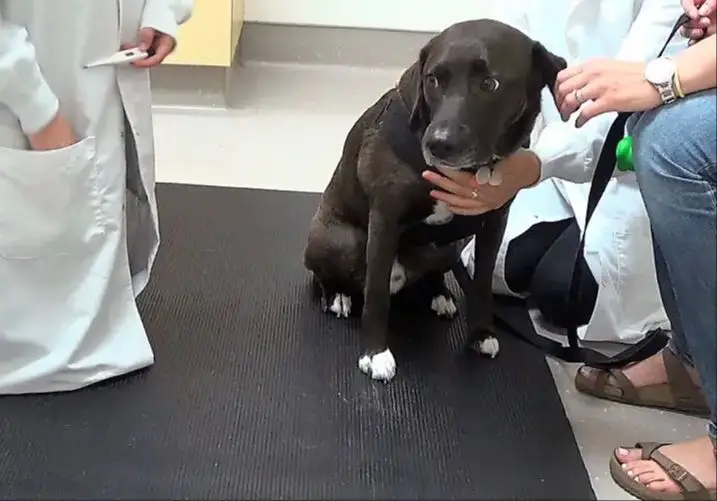Why Is My Dog Staring At Nothing?
We’ve all experienced it – you notice your dog gazing intently at a blank wall or corner, as if they are seeing something invisible. Their eyes are locked, ears perked, and body frozen. You call their name, but they remain transfixed. What could they possibly be looking at?
A dog staring at nothing is perplexing behavior for owners. On one hand, it seems like peculiar behavior. But on the other, there are several reasonable explanations for this phenomenon.
In this article, we’ll explore the common reasons behind this behavior in dogs and when it may signal an underlying medical issue requiring veterinary attention.
Normal Exploratory Behavior
Looking around and seeming to stare at something invisible is often perfectly normal behavior for dogs. Canines are naturally curious and like to explore their surroundings using their powerful sense of smell and excellent eyesight. According to the Merck Veterinary Manual, behaviors like looking around and sniffing are normal exploratory behaviors in dogs that allow them to gather information about their environment [1]. As pack animals, this ongoing information gathering also helps dogs gain confidence and become more aware of potential threats or resources [2].
So when your dog stares intensely at a blank wall or into an empty corner, it does not necessarily mean something is wrong. More likely, they are simply exploring their surroundings out of curiosity and instinct. The behavior is normal and harmless in most cases.

Senses
Dogs have a much keener sense of smell than humans. Their sense of smell is 10,000 to 100,000 times more acute than humans. They have up to 300 million olfactory receptors in their noses, compared to about 6 million in humans (source: Dog senses compared to humans). This allows them to detect scents we can’t even imagine. Dogs also have a powerful sense of hearing that enables them to detect sounds at four times the distance of humans.
Instincts
Dogs evolved from wolves as hunters and predators. As a result, they retain many of those instincts today despite being domesticated and living in our homes. Dogs have evolved to detect potential prey through both sight and smell. When your dog stares intently at something you can’t see, they may be relying on senses far superior to ours and responding to their natural hunting instincts.
According to Positive Reinforcement & Canine Coaching, predatory instincts are rooted deeply in the evolutionary history of dogs. This means even well-trained domestic dogs will respond automatically to certain triggers related to hunting. Staring blankly may indicate they are zoning in on smells or movements imperceptible to humans.
Memory
Dogs have strong associative memories based on scents and experiences from How A Dog’s Memory Works | Swift Blog. While they lack significant short-term memory, they can recall past events, people, places, and other dogs for longer than we previously thought. For example, research has shown that when dogs were taught to perform certain actions, they were able to remember and repeat those actions up to 10 minutes later. This indicates they have better episodic memory than we realized, rather than just associative memory What Do Dogs Actually Remember? | Southern Living.
When a dog stares at something invisible, it may be reacting to a smell or sound that triggers a strong memory. The dog could be remembering a past experience in that location and looking for something that is no longer there. Dogs can form memories at a young age that stay with them into adulthood. So even if you don’t know what happened in a certain spot before adopting your dog, they may still associate that area with a meaningful event from their past.
Boredom
Lack of mental and physical stimulation is a very common reason for staring behavior in dogs. When dogs are bored, they tend to zone out and stare blankly at walls or into space. This is one of the classic signs of boredom in dogs, according to sources like this PetHero article and this Chewy article.

Dogs need activity and interaction to keep their minds engaged. Without enough exercise, play time, training, or enrichment activities, your dog can quickly become restless and bored. Staring blankly is a way for dogs to zone out and pass the time when understimulated.
To prevent boredom staring, ensure your dog gets adequate daily exercise based on their age, health, and breed. Additionally, provide interactive toys and rotate through different chew toys to keep things interesting. Training sessions, games like fetch or tug of war, and food puzzle toys can provide much-needed mental stimulation as well.
Anxiety/Stress
Dogs can experience anxiety and stress just like humans. And when they do, they may stare off into space. According to PetMD, some common triggers for anxiety in dogs include loud noises, separation from owners, changes in routine or environment, and perceived threats. These things can cause a stress response in dogs that leads to anxious behaviors like staring blankly and being overly alert or vigilant.
As explained by VCA Hospitals, dogs may stare at walls or into space as a way to avoid eye contact or withdraw from a stressful situation. It’s one of the more subtle signs of anxiety in dogs, along with lip licking, yawning, and panting. So if your dog is staring intently at something invisible, it could signal underlying stress or anxiety. Try to identify and remove the source of stress if possible.
Age
Dementia becomes more common in older dogs, usually around the age of 10 or older. As dogs age, their cognitive functions decline and their brains undergo changes that can lead to disorientation and dementia. According to the Cornell University College of Veterinary Medicine, over 50% of dogs over the age of 10 show some signs of cognitive impairment or dementia (source).
Some of the most common symptoms of dementia in senior dogs include confusion and disorientation, anxiety when left alone, lack of house training, and forgetting familiar people or places. Owners may notice their older dog wandering around looking lost or confused, getting stuck in corners, failing to respond to cues, or having accidents in the home (source). As the dementia worsens, dogs can experience significant personality changes as well.

While dementia is not completely treatable or reversible, there are ways to manage the symptoms and slow progression. Providing mental stimulation, keeping routines consistent, using supplements, and medications can help improve brain health and quality of life for senior dogs with dementia.
Health Issues
Certain health conditions can cause dogs to stare blankly at walls or other objects. One common cause is canine cognitive dysfunction (CCD), which is similar to dementia or Alzheimer’s disease in humans. According to The American Kennel Club, CCD affects 14-35% of dogs by the time they are 15 years old. It can cause confusion, anxiety, aimless wandering, loss of housetraining, and staring.
Seizures and neurological issues may also lead to staring episodes, as noted by Southeast Veterinary Neurology. If seizures are suspected, other symptoms like collapsing, muscle twitches, chomping, and loss of bodily control may be present during the staring spell. Brain tumors, encephalitis, and other conditions affecting the nervous system should be evaluated by a vet.
Staring can additionally stem from liver or kidney disease, electrolyte imbalances, diabetes, dental pain, vision loss, or other issues. Any major change in behavior merits a full veterinary workup to pinpoint the cause. Treating underlying conditions often resolves the staring behavior.
When to See the Vet
If your dog is staring at seemingly nothing, it can sometimes be a sign of an underlying health issue that requires veterinary attention. Here are some key signs that it’s time to take your dog to the vet:
Red, tearing, or mucus-filled eyes could indicate an eye infection or other issue (Source). Discharge from the eyes, squinting, pawing at the eyes, or crusty eyes are other symptoms.
Missing more than two meals in a row may be a sign of an illness or condition affecting your dog’s appetite and warrants a vet visit (Source).
Other potential reasons to see the vet include lethargy, vomiting, diarrhea, limping, seizures, whining/yelping in pain, or dramatic changes in behavior. If your dog seems off their usual self, it’s better to be safe than sorry.

In an emergency, get to the vet immediately. Signs of an emergency include loss of consciousness, inability to breathe, uncontrollable bleeding, signs of extreme pain, seizures lasting over 5 minutes, or sudden paralysis.